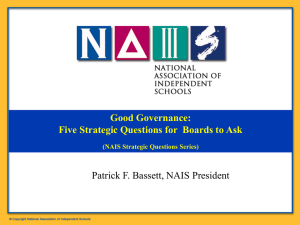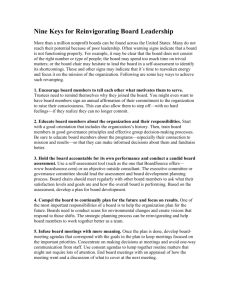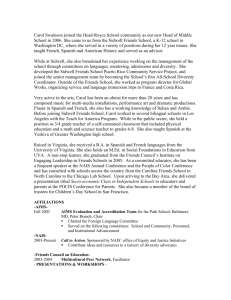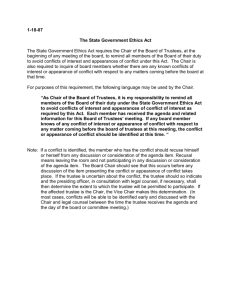Trusteeship 101 Powerpoint, Pat Bassett, NAIS
advertisement
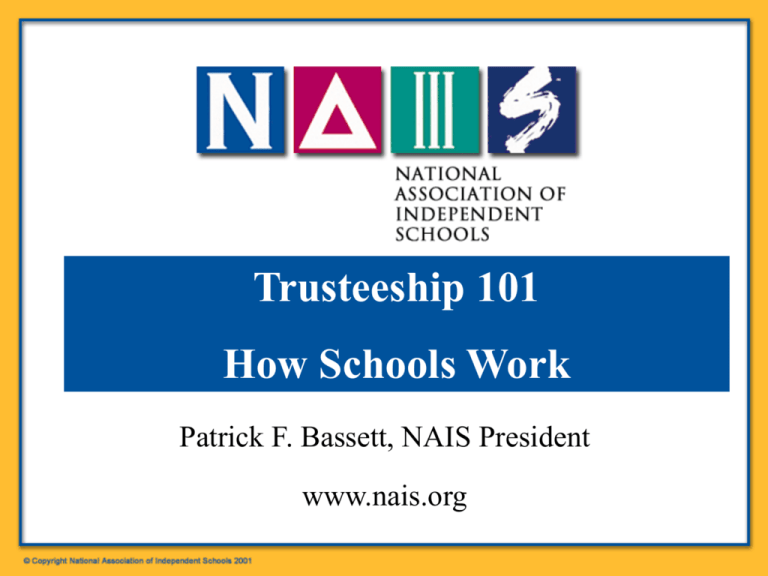
Trusteeship 101 How Schools Work Patrick F. Bassett, NAIS President www.nais.org Independence: Our Uniqueness Independent schools are independent in… Governance Finance Independence allows our school four vital freedoms: To define mission (and revise or refine it on occasion). To admit only those students our mission dictates we should serve. To establish our own expectations for credentials and performance of teachers. To teach the truth, as we see it (i.e., giving teachers the freedom to choose their own “relevant” curriculum and texts) The Evolution of a Math Problem (Why It’s Important for Schools Themselves To Decide Curriculum) From Education Insight, , Vol. 1, Issue 3, April/May 1994. 1960 - A logger sells a truckload of lumber for $100. His cost of production is four-fifths of this price. What is his profit? 1970 - (Traditional math) A logger sells a truckload of lumber for $100. His cost of production is four-fifths of this price, in other words, $80. What is his profit? 1970 - (New math) A logger exchanges set L of lumber for a set M of money. The cardinality of set M is 100, and each element is worth $1. The set C is the subset of M. What is the cardinality of the set P of profit? 1980 - A logger sells a truckload of wood for $100. His cost of production is $80, and his profit is $20. Your assignment: Underline the number 20. 1990 - (Outcome-based education) By cutting down beautiful forest trees, a logger makes $20. What do you think of this way of making a living? (How did the forest birds & squirrels feel?) Governance: Power Bases & Case Studies “It is easier to ask forgiveness than permission.” The Board of Trustees The Faculty DecisionMaking The Parents & The Parents Association (& The Advisory Board or Alumni Board) The Head & Administration Governance: Power Bases & Case Studies The Board Self-perpetuating (not parents’ reps) The board’s job is to govern (“steer” above the storm) by… • Holding the school and its mission “in trust.” Fiduciary duties of care (prudence, good faith, best interest), loyalty (no conflict of interest, confidentiality), and obedience (congruence with mission, bylaws, laws of the state). • Setting policy (admissions, diversity, financial aid, class size, compensation, endowment.) • Strategizing for the future: Strategic Posture vs. Plan. • Conducting Business via Committees & Task Forces (3 Levels) • Advocating the School: 3 R’s. • Hiring, supporting, and teaming with the head. • Evaluating the performance of head, board, and school. (Accountability: data-driven management via StatsOnline; the Balanced Scorecard; tracking alums; mission map) Governance: Power Bases & Case Studies The Parents & PA, Advisory Council, &/or Alumni Council Self-selected “customers” of school: PA, Advisory Council, &/or Alumni Council job is to... • Speak as voice of the constituency, in advisory role. • Offer forum for input to school: sounding board. • Educate the constituency: e.g., NAIS Parents Series* • Create a welcoming climate for all. • PA: Works to meet current needs of school. • Alumni Council: Works to preserve the best of the past. -----------------------------------------------------------------*Excerpt from NAIS Parents Series: “It’s a blessing to have a crabby, unenlightened, uninspired 4th grade teacher….” ~Wendy Mogel, author of The Blessing of a Skinned Knee Headmaster Fantasy of the Ideal Parent "I just wanted to stop by to thank you for the job you've done with our child. We know he's just slightly below average in intelligence, as we are, so the fact that he's learned anything here is amazing to us.” “We’re thrilled that his class includes that one disruptive kid and that his teacher has strong opinions on matters we disagree with.” “We applaud that decision you made, in the name of diversity, to change the 35 year old traditional Christmas pageant to a winter festival.” “By the way, don't you think we should have one or two more annual fundraisers so that we can supplement that12% increase in tuition with some real money?" Governance: Power Bases & Case Studies The Faculty • Appointed and evaluated by head The Faculty’s job is to… • Teach and care about students. (“In elementary school we love the kids, in high school we love… the subject, and in college, we love… ourselves.“) • Meet the needs of the school’s customers. • Grow professionally to lead program development. (“What research team are you on, and how is what you’ve learned manifest in your students’ electronic portfolios?) • Project a positive attitude (“high performance /good attitude”) Governance: Power Bases & Case Studies The Head Appointed by the board, its only employee. The head functions as... “The mayor” whose job is to... • Negotiate peace among parents, faculty, board (and other constituencies). • Oversee day to day operations. • Execute policies as set by board. • Serve as faculty’s colleague, advocate, and boss. Also functions as leader of jazz band: • Responsible for laying down the theme & encouraging talented partners to improvise. Head Authority March 23, 1891 My Dear Sir: It is my desire that this communication to you concerning your son and his iniquities will neither offend your sensibilities nor cause a diminution of the mutual esteem that we hold for one another. I am expelling as of this date your son. His very presence here bodes ill for my school. I will not tolerate a liar and a cheat. Your obedient servant, The Headmaster …And then There’s the Student… Governance: Boundary Crossings ...by the Board: e.g., bullying the head or misreading the culture of schools …by Parents: e.g., assuming a stockholder posture & politicizing demands: the telephone call to the trustee: “All the parents think….” – To Avoid: The S.U.V. caucus (parking lot mafia) – New banner & policy for schools: “Having your say does not equal getting your way.” – Parental Signed Covenants and “Parents on Probation” …by the Head: e.g., free-lancing on policy or getting out too far in front of the troops: “You must always cultivate the favor of the inhabitants.” ~Machiavelli …by the Faculty: e.g., subverting administrative or board policies, undermining collegiality, or ignoring the quid pro quo with parents. Resources from NAIS: www.nais.org. CASE STUDIES Resources for Boards www.nais.org “Search” on topics by term (e.g., “tuition remission”; “Browse Library” for Leadership & Governance. In “About NAIS,” click on “Principles of Good Practice.” Scroll down to “governance” in the Frequently Asked Questions (FAQs) section under Resources & Statistics NAIS Publications for Trustees: Trustee Handbook; Trustee Pamphlet Services. Order from the publications page on the NAIS website. Board Online Assessment Tool (BOAT) and Head Assessment Tool (HAT). BoardSource: General resources for non-profits. Case studies: search for “case studies” on www.nais.org and www.csee.org and www.globalethics.org. Email NAIS for assistance (when all else fails!): governancehelp@nais.org The End! For More Resources on this Topic, Go to www.nais.org Appendix Related Slides Statutory Duties The Law says you collectively... • Are responsible for the "business of the institution" • Have power to promote and preserve it • Must follow bylaws, policies, common law • Must monitor operations • Can appoint and delegate Statutory Duties The Law says a Trustee must individually exercise: • Ordinary prudence • Loyalty • Obedience Statutory Duties • "Prudence...care you use in handling your own business & personal affairs" • "Loyalty...undivided allegiance to the corporate purpose" • "Obedience...carry out institutional purpose per articles of incorporation & bylaws" Statutory Duties “Obedience...carry out institutional purpose per articles of incorporation & bylaws” Sample Provision: “The head of school shall have full charge of the administration of the educational program of the school; the admission and expulsion of students; and the administration of the faculty and other staff of the school. The head shall have full authority on behalf of the board of trustees to take any and all actions necessary for the proper conduct of the school as such, subject only to the power of removal vested in the board of trustees and to such budgetary restrictions as the board of trustees shall from time to time impose.” Developing the Board Adapted with permission from the May 2004 edition of Board Member, Volume 13, Number 3. BoardSource (c) 2004. The SAT Analogy: Our board is to our school as is to . Our admin team is to our school as is to . Problem Solving via Strategic Governance Needed: Three Levels of Trusteeship Level One: Fiduciary (auditing function of oversight and assessment of mission & finance) Level Two: Strategic (leadership function: “less management/more governance” via scanning and planning) Level Three: Generative (visionary function of shared leadership, R&D orientation for imagining and experimenting). Three Levels of Board Governance Adapted with permission from the May 2004 edition of Board Member, Volume 13, Number 3. BoardSource (c) 2004. Board as Control Mechanism Board as Direction Setter (Strategic, Board as Meaning Maker (Generative, Dam :: River Compass :: Navigation Inspiration :: Poet Curbstone :: Road Headlights :: Auto Values :: Choices Border Collie :: Herd Guidance System :: Satellite Designer :: Work of Art (Fiduciary, Oversight: “Doing things right”) Traffic Tower :: Pilot Governor :: Engine Landlord :: Tenant Anchor :: Ship Leadership: “Doing the right things”) Periscope :: Submarine Flight Planner :: Pilot Visionary: “Leaving a legacy”) Spirit :: Higher Purpose Lighthouse :: Ship Rudder :: Ship “The antidote to micromanagement is macroengagement.”~Dick Chait. Three-Tier Thinking Rising Benefit Costs: – Fiduciary thinking: “Increase co-pays” to share costs with employees” – Strategic thinking: “Market our absorbing of increased costs as recruitment/retention benefit” – Generative thinking: “Form a benefitpurchasing consortium” Three-Tier Thinking Add another Foreign Language: – Fiduciary thinking: “OK: which other language do we drop?” – Strategic thinking: “Why don’t we offer small enrollment courses (language or whatever) on an a la carte pricing basis? – Generative thinking: Which languages will be not a feature but a benefit in terms of market niche and longterm advantage to graduates? (German after WWII, Russian after Sputnik, Arabic now, Chinese next?) – “Chinese is strategic in a way that a lot of other languages aren’t…. Planning to be ready to engage with (the Chinese) rather than only thinking of them in terms of a challenge or a competitor is the smart thing to do.” Scott McGinnis, on the rising popularity of Chinese classes in American public schools. (Newsweek, 10/24/05) “The Best Way for Boards To Operate ~Hugh Price, Chronicle of Philanthropy, 01/26/06 (Sr. Fellow at Brookings Institute, former CEO of National Urban League and Rockefeller Foundation VP Micromanagers need not apply: boards that perpetually get in the CEO's backfield create chaos by transmitting mixed signals about who is in charge day in and day out. Authentic commitment to the enterprise and ability to shoulder the burdens of trusteeship Expertise that augments the skills of senior management in such crucial areas as finance, deal making, and marketing. A worldview that helps management detect and comprehend relevant and noteworthy trends that might not be spotted from inside the organizational bunker. Personal wealth, institutional resources, or influential contacts that help the organization generate critically important grants, contracts, or endowment gifts. Financial acumen to ensure that management cannot pull the wool over directors' eyes and that the organization meets all audit, tax, and reporting obligations. Diversity. Ethnic and gender diversity matter enormously because they greatly enrich deliberations and help keep the organization in touch with the real world. Governance Case Studies 13, 29, 1, 5, etc. The Brutal Facts: • Case Study #13: “Taking Charge: The Case of the Eager Beaver Trustee”: How do the head and board chair respond? Download from: http://www.blueskybroadcast.com/Client/NAIS/Case/case.html • Volatile Version: A prominent board member & current parent calls the head of school to say, “I just learned what your middle school science teacher said in class yesterday—if you don’t fire him, I’m withdrawing my $250K pledge to the capital campaign.” How does the head handle this “high stakes” call? What does the board chair do? • International School Version: the call is from the Minister of Education who sits on the board and who threatens to deport the head if he keeps allowing the teachers to give his son so much homework. The Case of the Eager Beaver New Trustee Leadership Issues in Play & Ethical Practices at Stake: Is it ever appropriate for an individual trustee to go on his or her own exploratory investigations? To give orders to staff? What about the “reporting path” for business managers, admissions directors, and development directors, who frequently have board committees that they staff and provide information for committee chairs who in the course of their work sometimes need and request detailed reports? When there is a “breakdown” of the governance/management boundary by a new or aggressive trustee, how can the damage be repaired and prevented from happening again? The Case of the Eager Beaver New Trustee NAIS’s Take on the Leadership Issues in Play & PGPs at Stake Trustees who work alone instead of as members of their boards can undermine the work of their boards and their heads of school. Generally, individual trustees and boards should not be involved in the day-to-day operations of the school and should keep their focus and work on the strategic bigger picture. Boards should have a process in place to gather the information it needs to make strategic decisions. Generally, the head delegates report generation to the appropriate key administrators, but sees, edits as necessary, and approves the report before the administrator delivers it to the board. Thus, the reporting path to the committee chair is through the head of school. The admissions director and business manager and development director must maintain the confidentiality of individual and institutional records and should inform the head if the security of these records is threatened. The Case of the Eager Beaver New Trustee NAIS’s Take on the Leadership Issues in Play & PGPs at Stake To prevent bad behaviors from “rogue” trustees, the Committee on Trustees should conduct adequate board orientation and training, including intensive “onboarding” to the culture and governance vs. management boundaries of independent school decision-making. Frequently, there should be board-training for the whole board, using NAIS case studies like this one. Annually, board members should sign, along with their “conflict of interest” document, a “board contract” stipulating expectations of board members. (Samples available on the NAIS website.) Generally, the “correction of course” for a boundary-breaking trustee simply requires a conversation from the board chair. If that fails, then the board chair, Committee on Trustees chair, and a board colleague/friend need to go on a “walk in the woods” with the misbehaving board member. If that fails, boards should have and use the trustee removal clause in their bylaws. Return Governance Case Study #29: The Letter Download from: http://www.blueskybroadcast.com/Client/NAIS/Case/case.html The Brutal Facts: Disgruntled Parent Version • A disgruntled parent board member decides to quit the board and remove her children from the school in a fit of pique over her child’s placement with a teacher she doesn’t like. • In an act of public defiance and retribution, she send a “It is with a heavy heart I must leave the school I love…” letter to all the board and parents, indicating her loss of confidence in the effectiveness of the leadership of the head and the board. • The letter causes quite a stir of concern in the parent body, not to mention the board. • What’s the board and head to do? Governance Case Study: The Letter NAIS Position: How to counter a PR assault • It’s time to call your media-crisis consultant to help draft a letter to parents and to plan the response to the media if they come knocking. • It’s important for the whole board to get on board with repudiating the means of assault, especially if it’s an anonymous letter or email to the community, as “shameful” and remind the community how conflict is supposed to be resolved in a civilized school community. • Loose cannon board members should be screened out in a “try-out” system before being appointed or “termed out” after a single term. • Board “contracts” and “parent contracts” should establish behavioral expectations, including email and letter-writing protocols. • Boards must establish and respect the role of and boundaries for the board members. Return Governance Case Study#1: Harsh Transitions Download from: http://www.blueskybroadcast.com/Client/NAIS/Case/case.html The Brutal Facts: • Head has hired a new fourth grade teacher. • Strong and vocal group of parents decide they don’t like her and are about to launch a petition among parents asking for her replacement, immediately. • Main complaints: “She’s too demanding. Doesn’t fit the culture of our school.” • Head’s judgment: “She’s the best teacher in the school.” • Board members getting calls: What’s the head do now? ----------------------------------------------------------International School Version: • The group is one nationality or another that thinks the program, texts, and staff are not American enough or British enough or host-country enough. Governance Case Study: Harsh Transitions NAIS position: How to handle parent “complaint calls” • Board members re-direct the calls to the appropriate staff member • Head supports the teacher but also “trouble-shoots” with the teacher. • If necessary, the academic leadership meets with small groups of parents to discuss the issues. • Eventually either the community starts to see the virtue in the teacher and program, or someone moves on • Boards must know the role of and boundaries for the parent body. Return Governance Case Study #5: Clash of Styles Download from: http://www.blueskybroadcast.com/Client/NAIS/Case/case.html The Brutal Facts: • Head is in her sixth year of a very successful tenure in terms of school growth, parent satisfaction, and introduction of new ideas. • A highly respected segment of the senior faculty, however, is not happy with many of the changes and begins to express its unhappiness to their friends on the board. • Prior to the April evaluation session by the board of the head, a senior faculty confides to the board chair that there is a movement afoot for faculty to vote “no confidence” in the head. • What’s the board do now? Governance Case Study: Clash of Styles NAIS Position: How to handle a faculty revolt. • Examine openly the extent to which board members have neglected to cut-off such “off the record” complaints. • Co-define with the head “what’s important” and “high impact” activities, and evaluate the head accordingly, the “substance” rule. • Recommend that the head conduct a “school climate survey” among the faculty and staff to ascertain the health of the climate and to seek counsel on how to address issues to improve it if necessary. • Boards must know the role of and boundaries for the faculty. Return Independence: Trustee Case Studies 1) You are watching your school (lose a hockey game) (perform abysmally on stage). Your child has often complained that the coach is "no good" and "mean." Another parent makes a remark indicating she doubts the abilities of the coach. (a) You tell the parent that you're concerned, too, and will mention it at the next Board meeting. (b) You change the subject and not report the conversation to the Head. (c) You ask around to see if others share your doubts, then report your findings to the Chairman of the Board. (d) You find an opportunity to talk to the Head about your worries. (e) You write a note to the AD/Department Chair to report parent concerns. Answer: 1. D: The inclination "not to bother the head" is often misguided: heads appreciate input from various sources. If indeed the coach is unskilled and unsuccessful with kids, your comments may not be the first the head has heard on the topic, but they may be helpful in presenting an overall picture of a situation needing some attention. NOTE: You should advise the unhappy parent to talk directly with the coach. Independence: Trustee Case Studies 2) You are a member of the Executive Committee and President-elect of the Board of Trustees. You receive a registered letter signed by the faculty expressing their disapproval of the firing of the school librarian (15 years with the school) and asking for a meeting with the Trustees. Your committee had discussed the impending firing with the Head before the action was taken and had both agreed that it was necessary and helped to work out the timing and terms of dismissal. (a) You call the Head, report the mailgram and say that you feel it is necessary to meet with the faculty, preferably without the Head, at least to show them that you are open to their concerns. (b) You call the present Chairman of the Board and ask that a response be made to the faculty from the Board. (c) You ignore the Mailgram, assuming that the Board Chairman and/or Head will handle it. (d) You send a reply to the faculty saying that although you understand their concern, hiring and firing decisions are the domain of the Head, whose action you support. (e) You call the Board Chairman and ask for a special Board meeting to deal with the crisis. Answer: 2. B: One person speaks for the Board, the Chair. The Board must not be seen as a court of appeal by which to circumvent the decisions of the head, for such a posture inevitably undermines the authority and therefore the effectiveness of the head. The board chair would do (d), supporting the authority of the head. Independence: Trustee Case Studies 3) You have overheard several conversations in which your child and other students discuss the drinking habits of a teacher. They feel he is often absent and/or hung over on Monday mornings - and his reputation as a heavy evening and weekend drinker is well established, at least among the students. (a) You report the accusations to the Head. (b) You tell the students that if they have real proof of their accusations they should speak to the Head, and if not, they are spreading rumors that are unfair and dangerous. (c) You bring the accusations up at a Board meeting. (d) You discuss the problem with the Chairman of the Board. (e) You ask the students what proof they have, and then inform both the Head and the Chairman of the conversation. Answer: 3. A: The issue here is the proper boundary between board (governance, sets policy) and head (administration, in charge of day to day operations, including supervision of personnel). Board members should never place themselves in the position of assuming a quasi-administrative role, as would be intimated by counseling of the students or by probing for evidence. The head must be advised of such charges or rumors, and perhaps the Board Chair, as well (although good practice would dictate that the head routinely share such concerns with the Board Chair and in some cases with the Board Personnel Committee). Independence: Parents Case Studies 4). You have learned that the school is about to implement a new sex-ed curriculum, and when you ask to see the syllabus for the program, you are horrified that topics include some you hoped your son or daughter would never hear about, much less discuss. (a) You bring the syllabus to the neighborhood cocktail party to find out how many other parents are apprised of the new program. (b) You send a mailing to all parents, with a petition asking that the school drop the implementation of the new program and leave sex ed up to individual parents, where it belongs. (c) You write to the head of the school and copy the parents association officers to let the head know that at least you would object to the new program and that you suspect there might be other like-minded parents who would object as well, seeking some relief from the requirement on an individual basis. (d) You call the Head of the school to threaten removing your children is the curriculum is implemented. (e) You swallow hard and tell your child to feign illness during sex-ed class, and remove himself or herself to the school nurse. Answer: 4. C. In almost all cases dealing with curriculum, we’d counsel you trust the expertise of teachers and school authorities, the exception being issues that have religious and moral dimensions to them. In these cases, you may try to appeal for a “waiver,” but know that it may be a request not honored. Independence: Parents Case Studies 5). You see your child's backpack on the chair at home, pick it up and a note drops out. Without thinking, you open the note and discover it is an invitation to the entire sophomore class to a party at a student's house on Saturday evening (B.Y.O.B.). The student is the son of a friend of yours, and you know that the parents will be out of town that weekend. (a) You confront your son about the note, threaten to call the school about the planned party, but relent when he objects strenuously, accusing you of spying and indicating that you will ruin his place among his peers. (b) You decide to replace the note and decide not to mention it, given the circumstances under which you discovered it, but you make some arrangements for your son to be away for the weekend. (c) You tell your spouse of the discovery but your spouse argues that no matter what else happens, by contacting the school, you will ruin the friendship between the two boys, and between you and your friends. (d) You call your friends and indicate to them that you hope that they will alert the school to intervene to make certain the message is disseminated that the party will not occur. You wait a day, then follow up with the school. (e). You call the Realtor and put your house on the market. Answer:5. D. The reason schools have trouble getting students to confront bad behavior with one another is that adults won’t confront adults who are being irresponsible. The school has a legal and moral obligation to notify, since illegal behaviors are likely to occur, and the arrangements for them happen at school. Return NAIS Publications for Trustees

